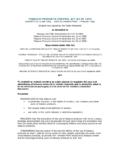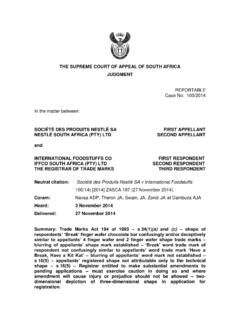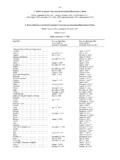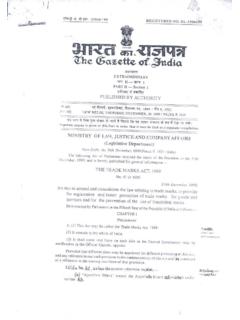Transcription of Trade Mark Opposition Decision 0/364/02 - ipo.gov.uk
1 1 Trade marks ACT 1994 IN THE MATTER OF APPLICATION No 2020540 BY HI-SPIRITS INTERNATIONAL LIMITED TO REGISTER THE Trade MARK: BOSS IN CLASS 32 AND IN THE MATTER OF Opposition THERETO UNDER No 52025 BY BRANDBREW SA BASED UPON THE EARLIER Trade MARK: BASS (and others) 2 Trade marks ACT 1994 IN THE MATTER OF Application No 2020540 by HI-SPIRITS INTERNATIONAL LIMITED to register the Trade mark: BOSS in class 32 and IN THE MATTER OF Opposition thereto under No 52025 by Brandbrew SA Background 1) On 13 May 1995 Hi-Spirits International Limited applied to register the Trade mark BOSS in respect of the following goods in class 32 of the International Classification of Goods and Services: beers, lagers, ales, mineral waters and non-alcoholic beverages The application was published on 8 November 2000. 2) On 18 January 2001 Brandbrew SA filed notice of Opposition to this application.
2 3) The opponent states that he is the proprietor of the following United Kingdom Trade mark registrations: no 292276 for the Trade mark BASS for beer no 996159 for the Trade mark BASS for beer, ale, stout and porter; shandy; beverages containing beer and included in class 32; and preparations included in class 32 for making all the aforesaid goods no 21701 for the Trade mark : for beer no 996152 for the Trade mark: for beer and preparations included in Class 32 for making beer 3 no 2001325 for the Trade marks : for ale All the above registrations are in class 32 of the International Classification of Goods and Services and currently stand in the name of the opponent. 4) The opponent states that the Trade mark in suit is phonetically and visually similar to the word BASS, which he states is a distinctive element of all his Trade marks .
3 He states that the goods encompassed by the respective Trade marks are identical or similar. Consequently, registration of the Trade mark in suit would be contrary to section 5(2)(b) of the Act. 5) The opponent states that he or his predecessors in title have been using the Trade mark BASS for well over 100 years in relation to beers and other alcoholic drinks and as a result a considerable reputation and goodwill has been acquired. Consequently, use of the Trade mark in suit would offend against the law of passing-off and so its registration would be contrary to section 5(4)(a) of the Act. 6) The applicant filed a counterstatement denying the grounds of Opposition . 7) Both parties filed evidence and seek an award of costs. After the completion of the evidence rounds I advised the parties that I believed a Decision could be made without a hearing.
4 However, the parties were advised that they retained their right to a hearing. Neither party requested a hearing so I will make a Decision after a careful study of the papers. Opponent s evidence 8) This consists of a statutory declaration made by Stuart Newland. Mr Newland is the director of business services of Bass Brewers Limited (BBL). Mr Newland states that BBL and Interbrew SA are both subsidiaries of Interbrew SA. 9) Mr Newland states that in 1777 William Bass bought his own brewery in Burton-on-Trent. William Bass used his signature as a Trade mark to denote the beer brewed in that company. Mr Newland states that his descendants and successors have used that signature on products to denote both their origin and high quality. 10) Mr Newland exhibits at SN1 various labels displaying the word BASS. All the labels show the signature the subject of Trade mark registration no 21701 and the words BASS & Co s.
5 The labels emanate from between 1844 and 1937. All of the labels indicate that they are for some type of beer. 11) Mr Newland exhibits at SN3 a copy of Bass PLC s annual report and financial statement of 1996. He states that Bass PLC is the former owner of the BASS brewing business. Mr Newland states that it will be seen that BBL, the company within Bass PLC group primarily 4 responsible for the sale of alcoholic beverages, made an operating profit in 1996 of 157 million, the predominant portion of which would be attributable to the United Kingdom. It would appear that this figure does not relate solely to goods bearing the BASS Trade mark or goods which are beverages. There is reference to the sale of a gas business and to the Hooper s Hooch, Caffrey s Irish Ale and Carling brands. The document indicates that in the year 1995 the profit for BBL was 144 million.
6 12) Mr Newland exhibits at SN4 a copy of a newsletter of September 1996 called Horizons . He draws attention to pages 6 and 7 of this newsletter, which he states sets out Bass Brewers excellent record in producing goods for export. This newsletter shows a variety of Trade marks that the opponent uses including Tennents, Barbican, Hooch, Caffrey s and Staropramen. 13) Mr Newland exhibits at SN5 a copy of a pamphlet entitled The True Story of the Classic English Ale which gives the history of BASS pale ale. Mr Newland also refers in his declaration to a leaflet entitled The Story of Bass but this has not been adduced into the proceedings. 14) Exhibited at SN6 is a copy of an article about the painting Manet s The Bar at the Folies Bergere . This article refers to the presence in the painting of a bottle bearing a red triangle, which it identifies as the first Trade mark to be registered in the United Kingdom and to be in the ownership of BASS.
7 Mr Newland states that many artists have celebrated the opponent s product and that Picasso created over thirty works depicting the BASS pale ale bottle and its distinctive Trade mark. 15) Exhibited at SN7 are printouts from the opponent s website. The pages give the history of BASS. 16) Exhibited at SN8 is an empty tin of ale which bears inter alia the word BASS in the same script as the signature of registration no 21701. Exhibited at SN9 are samples of promotional material. All of these relate to beer. Certain of the materials do not bear any indication of date. However, others bear closing dates for competitions; from these it would appear that they emanate from well after the relevant date for these proceedings. 17) Mr Newland gives details of export sales. I do not see that these have a bearing upon my deliberations. He also gives figures for sales, which I presume emanate from the United Kingdom, from 1996 to 2000.
8 They are between 51 and 56 million. Again the figures all emanate from after the relevant date. Advertising figures are given. It is not indicated if these relate to the United Kingdom alone. Again the figures are for the period from 1996 2000, so after the relevant date. 18) Mr Newland states that goods sold under the Trade mark have been promoted widely throughout the United Kingdom and that the company is a sponsor of the The Publican Golfing Pub of the Year . He exhibits at SN10 an entry form for this competition for the year 2001. 19) Mr Newland ends his declaration with what can best be described as submissions rather than evidence of fact. Therefore, I will say no more about them but take them on board in considering my Decision . 5 Applicant s evidence 20) This consists of a witness statement by Christopher Wharton.
9 Mr Wharton is a director of the applicant. Mr Wharton states that the applicant is the owner of United Kingdom Trade mark registration no 1494241 for the Trade mark BOSS in class 32, which covers cider. Mr Wharton goes on to deal with use of the Trade mark for cider. As the specification of the Trade mark in suit does not encompass cider I do not consider that I need to say any more about the cider side of the business. Mr Wharton states that the applicant decided to extend his product range by selling lager. Mr Wharton goes on to give figures for the sale of lager from 1995 to 2001. The turnover starts at 76, 864 and ends at 216,858. Mr Wharton refers to where goods under the Trade mark BOSS have been sold but does not advise if all these locations relate to both the cider and the lager. So, it is not possible to be certain as to the locations in which the lager has been sold.
10 Mr Wharton states that no promotional literature has been produced for lager sold under the Trade mark BOSS. He exhibits at annex 2 an empty tin displaying the BOSS Trade mark. The tin indicates that the contents are lager. The tin has a sell by date of October 2002, there is no indication of when it was produced. Opponent s evidence in reply 21) This consists of a witness statement by Nicholas David Baker. Mr Baker is a Trade mark attorney. I would characterise his witness statement as representing submissions rather than evidence of fact. I will, therefore, say no more about it. However, I will take on board the submissions in reaching my Decision . Decision Likelihood of confusion 22) Section 5(2)(b) of the Trade marks Act 1994 states that a Trade mark shall not be registered if because: it is similar to an earlier Trade mark and is to be registered for goods or services identical with or similar to those for which the earlier Trade mark is protected, there exists a likelihood of confusion on the part of the public, which includes the likelihood of association with the earlier Trade mark.








